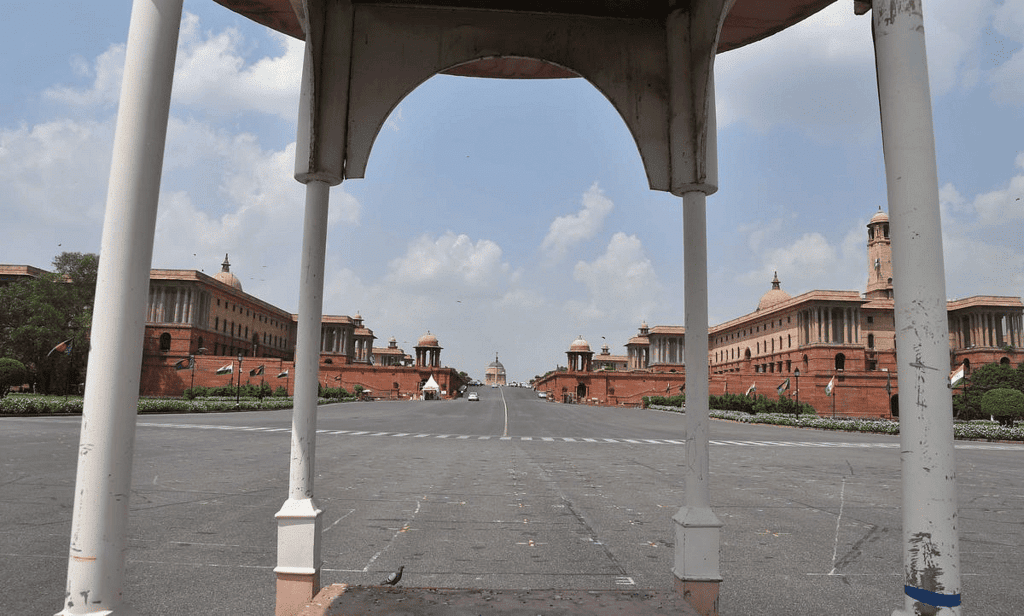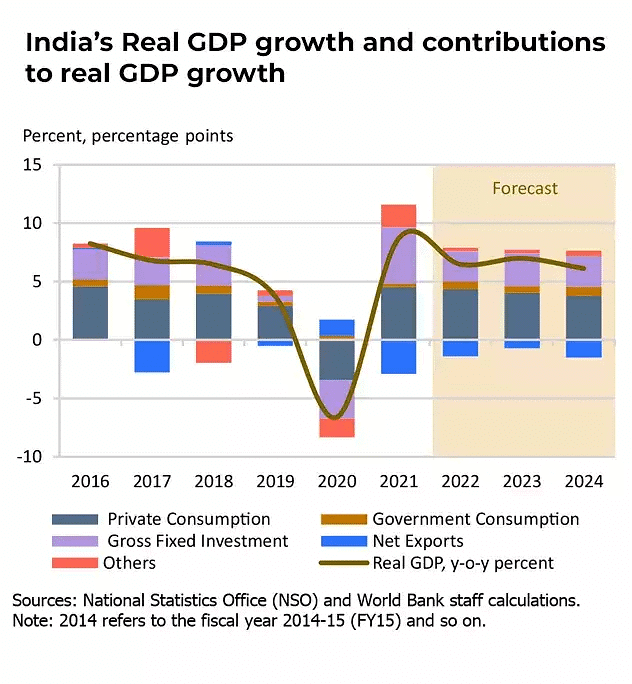UPSC Daily Current Affairs- 5th June 2023 | Current Affairs & Hindu Analysis: Daily, Weekly & Monthly PDF Download
GS-I
Sustainability of groundwater: Increased rainfall alone will not help groundwater recovery
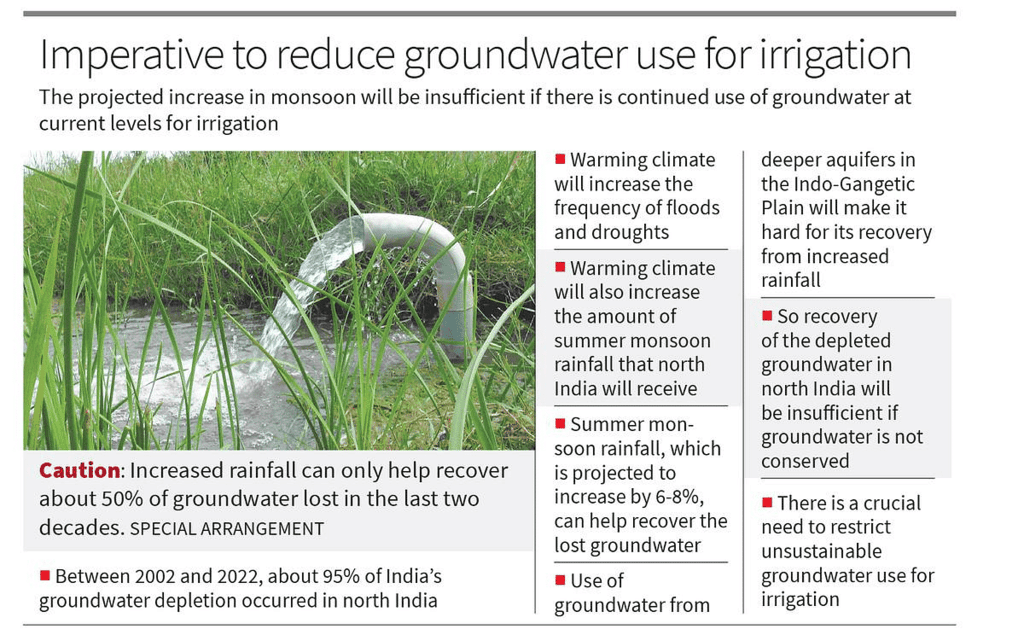
Why in News?
Between 2002 and 2022, about 95% of India’s groundwater depletion occurred in north India mainly as a result of increased groundwater pumping to meet irrigation demands for crops.
- As groundwater use and summer monsoon rainfall variability are the two main drivers of groundwater storage, climate change can throw new challenges for the sustainability of groundwater.
Groundwater Scenario in India:
- Availability:
- Groundwater is the water that seeps through rocks and soil and is stored below the ground. The rocks in which it is stored are called aquifers.
- This hidden resource accounts for just 0.62% of the total water and 30% of the freshwater available on earth.
- In India, out of the 1,123 BCM/year usable water resources of the country, the share of groundwater is 433 BCM/year (~39%).
- Groundwater crisis in India:
- Groundwater is India’s most used water resource accounting for a quarter of total GW extraction in the world.
- The challenges in groundwater resource management are complex and multifaceted. These include -
- Unregulated extraction; Excessive irrigation; Poor knowledge of GW management system; GW pollution; Climate change
- As per the 2021 CAG report, groundwater extraction in India increased from 58% to 63%, between 2004-17, exceeding the groundwater recharge rate.
- Over extraction at the current rate can threaten nearly 80% of drinking water over the next two decades.
- Governance:
- Legal framework in India does not explicitly define groundwater ownership and rights, as these are still determined by the archaic Indian Easement Act, 1882.
- These rights tied to land ownership rights exclude a large part of the society and lead to violation of the fundamental right to water and the right to life (Article 21).
- The Central Groundwater Board (CGWB) was formed in 1970 specifically to develop groundwater policies and programs.
- The Central Ground Water Authority (CGWA) was constituted under the Environment (Protection) Act, 1986.
- In 2004, the SC of India propounded the ‘public trust doctrine’ - making groundwater a matter of private ownership would be unjustified.
- Atal Bhujal Yojana (2019), Jal Shakti Abhiyan (2019) and Aquifer Mapping and Management Programme are some of the initiatives of the government of India for groundwater management.
Challenges to Groundwater Sustainability:
- Climate warming and unsustainable groundwater extraction:
- Warming climate will increase the frequency of hydro-climate extremes - floods and droughts.
- Warming climate will also increase the amount of summer monsoon rainfall.
- However, the projected increase in groundwater for irrigation can cancel the benefits of increased precipitation (in groundwater recovery) in the future.
- The role of increased evapo-transpiration due to warming climate:
- Evapo-transpiration is the sum of all processes by which water moves from the land surface to the atmosphere via evaporation and transpiration.
- It will limit water availability for groundwater recovery.
Way Ahead:
- There is a crucial need to restrict unsustainable groundwater use for irrigation. This can help in recovering groundwater storage with increased rainfall (due to climate change).
- There is a compulsion to make irrigation more efficient to promote groundwater conservation to ensure long-term sustainability especially during periods of drought.
- Satellite observations [from the GRACE Satellites of NASA] to understand the variability of groundwater storage and plan conservation initiatives accordingly.
Source: The Hindu
What are Khap Panchayats?
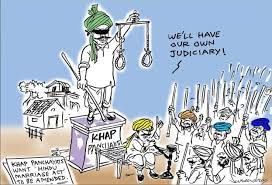
Why in News?
The Khap leaders are calling for swift action and the arrest of a Minister, who is accused of sexual harassment of wrestlers in order to address the allegations effectively and ensure justice.
- In order to escalate their demands and seek support for their cause, the khap leaders have decided to organize a delegation to meet with President.
Understanding Khaps
- Khaps are gotra-based and region-based social outfits: Khaps are social organizations that are primarily based on the gotras (clans tracing paternal lineage) and regions.
- How are they named?: They derive their name either from the number of villages/clusters of villages they represent or the gotras they are associated with.
Types of Khaps
- Gotra-based Khaps: They have jurisdiction in villages dominated by the respective gotras they represent.
- Region-based Khaps: They have influence over a specific region comprising a few villages to several hundred villages.
Features of Khaps
- Traditional dispute resolution: Historically, khaps served multiple functions, including resolving disputes among families and villages, upholding religious customs, and safeguarding the region from external invasions.
- Archaic decrees: However, their role in protection from invasions has become largely irrelevant today, and they primarily focus on dispute resolution and ensuring adherence to social and religious customs.
- Leadership and succession: Khaps lack a formal organizational structure when it comes to leadership and succession. While the position of khap president or leader was traditionally hereditary, it is no longer a strict rule.
Functions of Khaps
- Dispute Resolution: Khaps have traditionally played a significant role in settling disputes, both within families and between villages. They act as mediators and strive to find resolutions that are acceptable to all parties involved.
- Maintenance of Social and Religious Customs: Khaps are responsible for upholding social and religious customs within their communities. They ensure that traditions, rituals, and cultural practices are followed and preserved.
- Social Governance: Khaps exercise a form of social governance in their respective areas of influence. They enforce societal norms and standards, promoting social cohesion and harmony within the community.
- Community Welfare: Khaps often engage in activities aimed at the welfare of the community. This may include organizing social and cultural events, providing support during crises, and facilitating community development initiatives.
- Advice and Guidance: Khaps serve as a source of advice and guidance for community members. Individuals can approach the khap leaders for counsel on various personal, social, or legal matters.
- Representation and Advocacy: Khaps act as representative bodies for their communities, advocating for their interests and concerns. They may engage with local authorities, government officials, and other stakeholders to address community-specific issues.
- Preserving Lineage and Genealogy: Khaps play a role in preserving the lineage and genealogy of families within their communities. They maintain records and knowledge of ancestral connections, which can be important for social and marital customs.
- Protection of Community Interests: Historically, khaps also had a role in protecting the community from external threats, such as invasions. While this function is largely irrelevant today, khaps may still come together to address issues that affect the collective interests of their communities.
Power and Political Influence of Khaps
- Large associated population: Khaps draw power from their association with a significant number of individuals who identify with specific gotras or reside within their jurisdiction.
- Legitimacy through actions: Khaps gain legitimacy by acting as pressure groups and mobilizing people for political issues. Their ability to rally their members and exert pressure on authorities makes them influential players in politics.
- Active participation in protests: Khaps actively participate in protests and movements, amplifying the voices of the aggrieved and adding weight to their demands.
- Farmer agitation involvement: Khaps played a significant role in the farmer agitation against contentious farm laws, contributing to the success of the movement.
- Crucial players in politics: Khaps have emerged as crucial players in north Indian politics, with political parties seeking their support due to their widespread influence and large support base.
- Limited individual political success: While khaps hold political influence collectively, individual khap leaders have varying success in their personal political careers.
Issues with Khaps
- Regressive social customs: Khaps impose restrictions on inter-caste and intra-gotra marriages, limiting personal freedom and perpetuating caste-based divisions.
- Gender inequality: Khaps often discriminate against women, enforcing patriarchal norms and restricting their rights and choices.
- Involvements in honour killings: Khaps have been associated with honor killings, where individuals are killed for marrying against family or community wishes.
- Lack of legal authority: Khaps lack legal authority but exert social pressure and impose penalties, violating individual rights.
- Absence of democratic processes: Khaps lack transparent leadership selection and decision-making processes, leading to disputes and favoritism.
- Exclusion and discrimination: Khaps promote exclusion and discrimination based on caste, gotra, or other social divisions.
- Interference in legal matters: Khaps interfere in legal proceedings, challenging the authority of the judicial system.
Relevance of Khap
- Resolving local disputes: Khaps are relevant in rural areas for resolving local social disputes and providing a mechanism for conflict resolution.
- Upholding customs and traditions: Khaps maintain the relevance of social and cultural customs, contributing to the preservation of cultural identity.
- Community cohesion and solidarity: Khaps foster community cohesion and provide a platform for collective action and addressing shared concerns.
- Advisory and guidance role: Khaps offer advice and guidance to community members on personal, social, or legal matters.
- Advocacy for community interests: Khaps advocate for the needs and aspirations of their communities, ensuring their voices are heard.
- Sense of identity and belonging: Khaps contribute to a sense of identity and belonging by connecting individuals to their ancestral lineage.
- Social welfare and support: Khaps engage in activities for social welfare and community development.
- Political influence: Khaps hold political influence, with parties seeking their support due to their large support base and mobilization capabilities.
Conclusion
- Overall, a nuanced approach is necessary to recognize and respect the positive aspects of Khaps while addressing their shortcomings and ensuring a more inclusive and equitable society.
Source: The Hindu
GS-II
Asymmetric Federalism: Examining the Impact of the Delhi Ordinance
Why in News?
The recent promulgation of an ordinance by the Union government, amending the Government of National Capital Territory of Delhi (NCTD) Act, 1991, has raised concerns about federalism, democracy, bureaucratic accountability, executive law-making, and judicial review. This move nullified the Supreme Court judgment that recognized the elected government of Delhi’s legislative and administrative powers over services.
What is mean by asymmetric federalism?
- Asymmetric federalism refers to a governance model in which different regions or constituent units within a country are granted varying degrees of autonomy or special provisions based on their unique characteristics, circumstances, or historical factors.
- It recognizes that not all regions or constituent units are the same and may require different arrangements to accommodate their specific needs and aspirations
Key points regarding Delhi’s unique position and asymmetric federalism
- Sui generis status: The Supreme Court recognized that the addition of Article 239AA in the Constitution granted the National Capital Territory of Delhi (NCTD) a distinct and special status. This acknowledgment indicates that Delhi does not fit neatly into the category of either a full-fledged state or a union territory.
- Examples of special governance arrangements: India’s federal system already incorporates examples of asymmetric federalism. For instance, the special provisions under Article 370 (before its dilution) for Jammu and Kashmir and the protections provided under Article 371, as well as the 5th and 6th Schedule Areas, demonstrate the existence of differential treatment based on regional considerations.
- Legislative and administrative powers: The Supreme Court’s verdict on May 11 acknowledged that the elected government of Delhi possesses legislative and administrative powers over certain subjects, including services. This recognition further solidifies the idea that Delhi operates under a distinctive constitutional framework, allowing it to exercise powers similar to those of states.
- Federal entity status: While Delhi remains a Union Territory, the Court’s judgment emphasized that the unique constitutional status conferred upon it makes it a federal entity. This recognition affirms the existence of a distinct arrangement for Delhi within India’s federal structure.
- Contrasts with Jammu and Kashmir: It is worth noting that the Court’s application of asymmetric federalism principles in Delhi contrasts with the situation in Jammu and Kashmir, where similar principles were not upheld. This discrepancy highlights the need for consistent application and recognition of federalism across different regions.
Inconsistent Application of Asymmetric Federalism
- Differential treatment: Inconsistencies arise when different regions or constituent units within a country receive varying degrees of autonomy, special provisions, or protections based on their unique characteristics, historical factors, or political considerations.
- Unequal distribution of powers: In some cases, certain regions may enjoy greater devolved powers, legislative authority, or administrative autonomy compared to others. This disparity can create imbalances in decision-making and resource allocation, leading to perceptions of favoritism or discrimination.
- Varying levels of cultural or linguistic protections: Asymmetric federalism may involve granting special cultural or linguistic protections to specific regions or constituent units. However, the extent and nature of these protections can differ, leading to disparities in the preservation and promotion of cultural diversity and linguistic rights.
- Financial arrangements: Inconsistent application of asymmetric federalism can also manifest in the distribution of financial resources. Some regions may benefit from preferential funding or fiscal arrangements, while others may receive fewer resources, resulting in economic disparities and regional imbalances.
- Selective application based on political considerations: In some cases, the application of asymmetric federalism may be influenced by political factors, resulting in inconsistent treatment. Regions that align with the ruling party or have greater political influence may receive more favourable treatment, while others may be neglected or marginalized.
- Perception of unfairness and tensions: Inconsistencies in the application of asymmetric federalism can lead to a sense of unfairness, grievances, and tensions among regions or constituent units. This can undermine trust, unity, and cooperative governance within a federal system.
Challenges Posed by the Ordinance
- Judicial independence: The swift and brazen act of undoing a Supreme Court judgment through an ordinance raises concerns about judicial independence. While the legislature has the authority to alter the legal basis of a judgment, directly overruling it undermines the independence of the judiciary.
- Executive overreach: The use of an ordinance, which is meant to address extraordinary situations, for political ends raises questions about executive overreach. The Supreme Court has previously held that ordinances should not be perverted to serve political objectives, indicating that their use should be limited and justified.
- Constitutional subterfuge: The ordinance adds an additional subject of exemption (services) to the legislative power of Delhi without amending the Constitution. This raises concerns about constitutional subterfuge, as it potentially circumvents the constitutional amendment process and undermines the constitutional framework.
- Bureaucratic accountability: The creation of a National Capital Civil Service Authority, where appointed bureaucrats can overrule an elected Chief Minister, undermines established norms of bureaucratic accountability. This consolidation of power in the hands of bureaucrats weakens democratic principles and dilutes the authority of elected representatives.
- Assault on federalism: The ordinance directly assaults the principles of federalism by limiting the control and decision-making power of the elected government of Delhi. It erodes the federal structure by introducing a mechanism where Union-appointed bureaucrats and the Lieutenant Governor can overrule the decisions of the Chief Minister and the elected government.
- Threat to democracy: The ordinance’s provisions, including the majority voting system and the decision-making authority of the Lieutenant Governor, raise concerns about democratic principles. By allowing unelected officials to wield significant power over elected representatives, it undermines the democratic ideals of representative governance and the will of the people.
Way Ahead: The Need for a New Politics of Federalism
- Protection of constitutional values: As the foundations of India’s constitutionalism are threatened, a new politics of federalism is required to safeguard the core values enshrined in the Constitution. Federalism serves as a vital mechanism to ensure a balance of power, protect the rights of states and regions, and uphold democratic principles.
- Counter-hegemonic idea: By championing the principles of decentralization, autonomy, and cooperative governance, a renewed focus on federalism can challenge the concentration of power and promote a more inclusive and participatory political system.
- Normative framework: Opposition parties often fail to take a principled stance on federalism or articulate it as a normative idea. A new politics of federalism should aim to establish federalism as a guiding principle based on first principles, emphasizing the importance of cooperative governance, checks and balances, and the protection of regional diversity.
- Articulating underlying values: A reimagined politics of federalism should consistently articulate the underlying values of federal governance. This includes recognizing the interplay between federalism and democracy, understanding the diverse interests and aspirations of regions, and ensuring equitable distribution of powers, resources, and opportunities.
- Balancing the centre-state dynamics: A robust politics of federalism can foster a healthy balance between the central government and the states or regions. It should promote dialogue, cooperation, and respect for the autonomy and authority of elected representatives at all levels.
Conclusion
The recent ordinance amending the Government of NCTD Act has ignited debates about federalism, democracy, and bureaucratic accountability. Opposition parties must recognize the importance of federalism as a guiding principle and act to safeguard it. The protection of federalism requires a principled approach that upholds democratic values and ensures the balance of power between different tiers of government.
Source: The Hindu
Adverse Possession
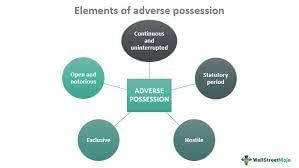
Why in News?
The Law Commission of India recenly recommended against enlarging the period of limitation provided under Articles 64, 65, 111, or 112 of the Limitation Act, 1963, which encapsulates the law on adverse possession.
About Adverse Possession:
- It is a legal concept that allows a person who has unlawfully occupied someone else’s land for a certain period of time to claim legal ownership of that land.
- The claimant, or disseisor, must demonstrate that several criteria have been met before the court will allow their claim.
- In India, adverse possession has been a part of the legal framework for a long time and is rooted in the idea that land must not be left vacant and instead be put to judicious use.
- To claim adverse possession, the occupier must prove that they have been in continuous, uninterrupted possession of the land for at least 12 years and that their possession was open, notorious, and hostile to the true owner.
- The law of Adverse Possession in India is governed by the principle of The Limitation Law of 1963.
- As per adverse possession under limitation act, if over a due course of time or period, if an appeal is not made to revise any limitation, the current scenario of titles continues.
- According to the Indian legal system, if a property owner fails to make a claim towards their property for 12 years, and the same tenant continues to occupy the property for 12 years, the ownership rights to the property is transferred to the tenant.
Source: The Hindu
GS-III
India’s GDP: Post-Pandemic Growth and Investment Challenges
Why in News?
India’s GDP level is still 5 percent below its pre-pandemic trajectory, despite recording an average growth rate of 8 percent over the past two years. This indicates the lasting impact of the pandemic and highlights the need for sustained growth of over 7-8 percent to avoid further GDP loss.
Factors Contributing to Sluggish Investment and Growth
- Global Trade Stagnation: Since the global financial crisis, global trade has experienced a slowdown, affecting India’s export-oriented industries and reducing foreign direct investment (FDI) inflows.
- Uncertain Economic Environment: Economic uncertainties, both domestic and global, have led to a cautious approach from businesses, resulting in lower investment levels. Factors such as policy volatility, regulatory hurdles, and geopolitical tensions contribute to this uncertainty.
- Decline in Corporate Investment: Corporate investment as a percentage of GDP has declined from its peak of nearly 14.5 percent in 2007-08 to around 10.5 percent. This decline can be attributed to factors like sluggish demand, high corporate debt, and a lack of investor confidence.
- Slowdown in Residential Housing: The slowdown in the real estate sector, particularly residential housing, has adversely impacted overall investment. Factors such as liquidity issues, regulatory changes, and subdued demand have led to reduced investment in the sector.
- Falling Small and Medium-Sized Enterprise (SME) Investment: Investment from SMEs, which play a crucial role in driving economic growth and job creation, has witnessed a decline. Barriers such as limited access to credit, regulatory complexities, and lack of technological capabilities hamper their investment potential.
- Insufficient Public Sector Compensation: While the central government has increased public sector investment, the overall public sector investment as a percentage of GDP has remained unchanged at 7 percent since the global financial crisis. This lack of compensation from the public sector has limited its ability to boost overall investment levels.
- Lack of “Crowd-in” Effect: The public sector’s inability to “crowd-in” private investment has contributed to sluggish growth. Despite efforts to stimulate private investment, the overall investment climate and business environment need further improvements to attract private players.
- Economic Challenges and Policy Reforms: India faces challenges such as demographic shifts, falling productivity, high indebtedness, structural inflation, and interest rates. These factors affect investor sentiment and may hinder investment and growth prospects.
Impact of Sluggish Investment and Growth on GDP
- Lower Economic Output: With reduced investment, businesses have fewer resources to expand operations, develop new products, and create employment opportunities. This, in turn, limits the overall output and growth potential of the economy.
- Unutilized Capacity: Slower investment hampers the utilization of existing productive capacity in various sectors. This underutilization leads to inefficiencies, decreased productivity, and a reduced contribution to GDP growth.
- Employment Generation: When businesses are hesitant to invest and expand, it results in limited employment opportunities. This can lead to higher unemployment rates, underemployment, and reduced household incomes, negatively impacting consumer spending and overall economic growth.
- Impaired Productivity: A lack of investment hampers productivity-enhancing measures such as adopting advanced technologies, improving infrastructure, and fostering innovation. Insufficient investment in research and development, training, and upgrading of machinery and equipment can lead to lower productivity levels.
- Reduced Business Confidence: When businesses lack confidence in the economy’s future prospects, they may delay or scale back investment plans, impacting productivity and growth. This can create a cycle of low investment and weak growth, further undermining business confidence.
- Fiscal Challenges: Reduced tax revenues and increased demand for social welfare programs can strain public finances, making it challenging for the government to allocate resources for critical development projects, infrastructure, and public services that contribute to economic growth.
- Macroeconomic Imbalances: Sluggish investment and growth can lead to macroeconomic imbalances, such as a higher fiscal deficit, current account deficit, and inflationary pressures. These imbalances can negatively affect the overall stability of the economy and impede sustained and inclusive growth.
Factors Influencing Future Growth
- Policy Reforms and Ease of Doing Business: The implementation of structural reforms and policies that promote ease of doing business can have a significant impact on future growth. Streamlined regulations, transparent governance, and business-friendly policies attract investment, foster entrepreneurship, and drive economic expansion.
- Infrastructure Development: Adequate and modern infrastructure, including transportation networks, power supply, digital connectivity, and social infrastructure, is crucial for sustainable economic growth.
- Human Capital Development: Investing in education, skill development, and healthcare contributes to the development of a skilled workforce, which is essential for innovation, productivity, and long-term economic growth.
- Technological Advancements and Digitalization: Embracing emerging technologies and fostering digitalization can boost productivity, enhance efficiency, and spur innovation. Investments in research and development, digital infrastructure, and technological adoption can drive future growth in sectors such as manufacturing, services, and agriculture.
- Trade and Global Integration: Expanding international trade and deepening economic integration can open up new markets, attract investments, and drive economic growth. Participation in regional and global trade agreements, removing trade barriers, and diversifying export markets can enhance competitiveness and create new opportunities for growth.
- Sustainable Development and Climate Change Mitigation: Transitioning towards sustainable practices, renewable energy, and green technologies can contribute to long-term growth while addressing environmental challenges. Investing in climate change mitigation and adopting sustainable practices can attract investments and promote responsible and inclusive growth.
- Financial Inclusion and Access to Credit: Promoting financial inclusion and ensuring access to affordable credit for businesses and individuals can fuel entrepreneurial activities, stimulate investment, and support consumption-led growth.
- Political Stability and Good Governance: Political stability, effective governance, and the rule of law provide a conducive environment for economic growth. Sound institutions, transparent decision-making processes, and the fight against corruption inspire confidence among investors and foster long-term economic development.
Supply Chain Relocation
- “China + One” Strategy: The supply chain relocation trend known as the “China + One” strategy involves companies diversifying their manufacturing and sourcing activities by establishing additional production facilities outside of China.
- Limited Absorption Capacity: While economies like India, Mexico, and Vietnam stand to benefit from the “China + One” strategy, their absorption capacity for large-scale relocations may be limited. These economies might not have the infrastructure, skilled workforce, or supporting ecosystem to absorb a significant influx of relocation investments.
- Size Matters: Inward FDI into China has remained substantial, indicating its continued attractiveness as a manufacturing hub. The sheer size of China’s market, its infrastructure, and established supply chains make it challenging for other economies to fully replace or surpass its role as a global manufacturing powerhouse.
- Security-Driven Relocation: Another aspect of supply chain relocation involves security concerns, particularly in advanced technology sectors such as advanced semiconductors, AI, and quantum computing. Countries, especially in the West, may relocate supply chains related to these emergent technologies to regions considered within their “circle of trust,” often referring to NATO and close allies.
Climate Change and Investment Opportunities
- Renewable Energy: The transition to a low-carbon economy presents significant investment opportunities in renewable energy sources such as solar, wind, hydro, and geothermal power. Investments in renewable energy infrastructure, research and development, and technology advancements can drive the growth of clean energy industries and contribute to decarbonization efforts.
- Energy Efficiency: Investments in energy-efficient technologies and practices can help reduce greenhouse gas emissions and lower energy consumption. Energy-efficient buildings, smart grids, efficient transportation systems, and industrial processes offer attractive investment opportunities that promote sustainability and cost savings.
- Sustainable Infrastructure: Developing sustainable infrastructure, including green buildings, eco-friendly transportation systems, waste management facilities, and water conservation projects, presents opportunities for investment. Sustainable infrastructure projects can enhance resilience, reduce environmental impacts, and contribute to sustainable development goals.
- Green Finance and Investment Products: The growing demand for sustainable investments has led to the emergence of green finance and investment products. These include green bonds, sustainable funds, and impact investments that prioritize environmental, social, and governance (ESG) factors. Investing in such financial products can align with climate change mitigation goals while generating financial returns.
- Carbon Capture and Storage (CCS): Investments in CCS technologies and infrastructure can help capture and store carbon dioxide emissions from industrial processes, power generation, and other sectors. CCS offers potential solutions to reduce emissions in industries that are challenging to decarbonize and can contribute to achieving climate goals.
- Circular Economy: Shifting towards a circular economy model, which focuses on reducing waste, recycling materials, and promoting resource efficiency, presents investment opportunities. Investments in waste management, recycling facilities, and innovative circular business models can drive sustainability and reduce the environmental impact of traditional linear production and consumption systems.
- Sustainable Agriculture and Forestry: Investments in sustainable agricultural practices, precision farming technologies, agroforestry, and sustainable forestry management contribute to climate change mitigation and adaptation. These investments can enhance food security, conserve biodiversity, and promote sustainable land use.
Conclusion
- India’s economic recovery from the pandemic has been encouraging, but the gap between current GDP levels and the pre-pandemic trajectory needs to be addressed. To achieve sustained growth, India must focus on revitalizing private investment, improving the investment climate, and actively participating in the global transition to a low-carbon economy. Only then can India mitigate the long-term scarring effects of the pandemic and ensure a prosperous future.
Source: The Hindu
What is Sonic Boom?
Why in News?
A sonic boom rattled US's Washington and Virginia recently after two F-16 fighter jets chased an “unresponsive aircraft” through the sky.
About Sonic Boom:
- A sonic boom is a thunderous noise caused by an object, like an aircraft, moving faster than the speed of sound.
- How is it formed?
- As the object zooms through the sky, the air molecules around it are pushed aside with tremendous force, generating shock waves along its flight path.
- The release of pressure, following the shock waves’ buildup, is heard as the sonic boom.
- Sonic booms create huge amounts of sound energy.
- The intensity of the sonic boom is determined not only by the distance between the craft and the ground but also by the size and shape of the aircraft, the types of maneuvers that it makes, and the atmospheric pressure, temperature, and winds.
- Generally, a larger aircraft will cause stronger shock waves, and therefore, a louder sonic boom.
- If the aircraft is especially long, double sonic booms might be detected, one emanating from the leading edge of the plane and one from the trailing edge.
- Sonic booms can shatter glass, but there is generally little risk for people on the ground.
Source: The Hindu
RBI’s lightweight’ payments system
Why in News?
Recently, the Reserve Bank of India (RBI) announced the conceptualisation of the ‘lightweight’ payments system.
About RBI’s lightweight’ payments system:-
- The lightweight’ payment system is to ensure uninterrupted digital payments during emergencies such as natural calamities or war.
- Background: the RBI is working on strengthening the oversight framework for Centralised Payment Systems as part of the Utkarsh 2.0 initiative.
Salient Features:-
- This system will operate independently of existing payment technologies like UPI(Unified Payment Interface), NEFT (National Electronic Funds Transfer), and RTGS(Real-Time Gross Settlement (RTGS))
- It can be operated from anywhere.
- It requires minimal staff during emergencies.
- It will process critical transactions, such as bulk payments and interbank payments, during extreme and volatile situations.
- The system operates on minimalistic hardware and software.
- It gets activated only when needed.
Lightweight’ payments system v/s UPI(Unified Payment Interface)
- UPI and other conventional systems prioritise handling large transaction volumes and require a stable and robust infrastructure.
- On the other hand, the lightweight system is designed to operate even in volatile and extreme conditions when regular payment systems may not be accessible.
Utkarsh 2.0:
- In January 2023, the Reserve Bank of India (RBI) launched Utkarsh 2.0, which is the second phase of its medium-term strategy for strengthening regulatory and supervisory mechanisms.
- Utkarsh 2.0 builds upon the foundation laid by Utkarsh 0.1, which was launched in July 2019 and covered the period from 2019 to 2022.
- Utkarsh 2.0 will guide the RBI over the period from 2023 to 2025 and includes six vision statements that are designed to improve the performance of the RBI’s statutory and other functions, enhance its relevance and significance at the national and global levels, and improve its internal governance, infrastructure, and human resources.
- The six vision statements are:
- Excellence in performance of statutory and other functions:
- Strengthened trust of citizens and institutions in the RBI:
- Enhanced relevance and significance in national and global roles:
- Transparent, accountable, and ethics-driven internal governance:
- Best-in-class and environment-friendly digital and physical infrastructure: This vision statement seeks to improve the RBI’s digital and physical infrastructure by making it the best-in-class and environmentally friendly
- Innovative, dynamic, and skilled human resources
Source: The Hindu
|
63 videos|5408 docs|1146 tests
|


